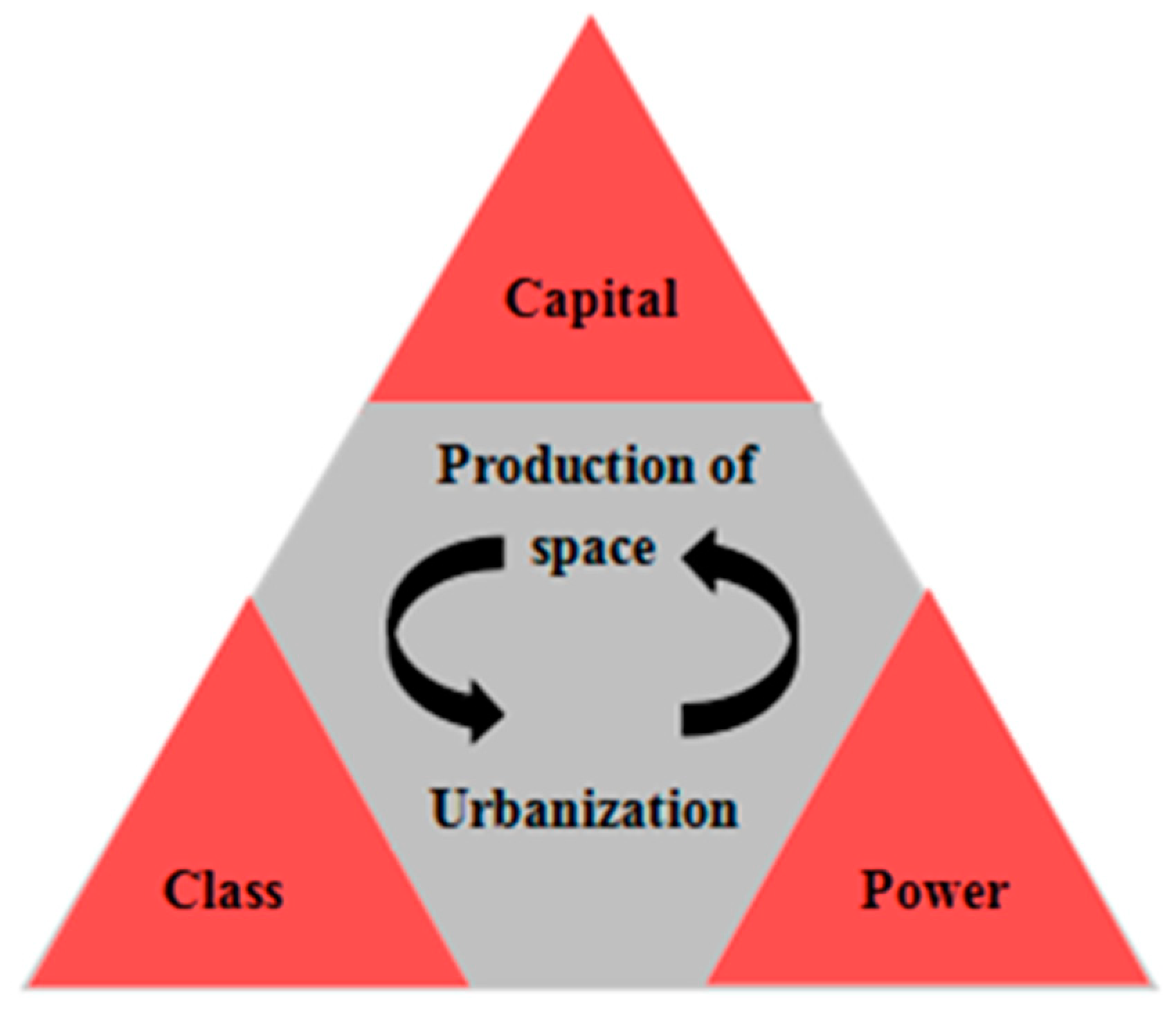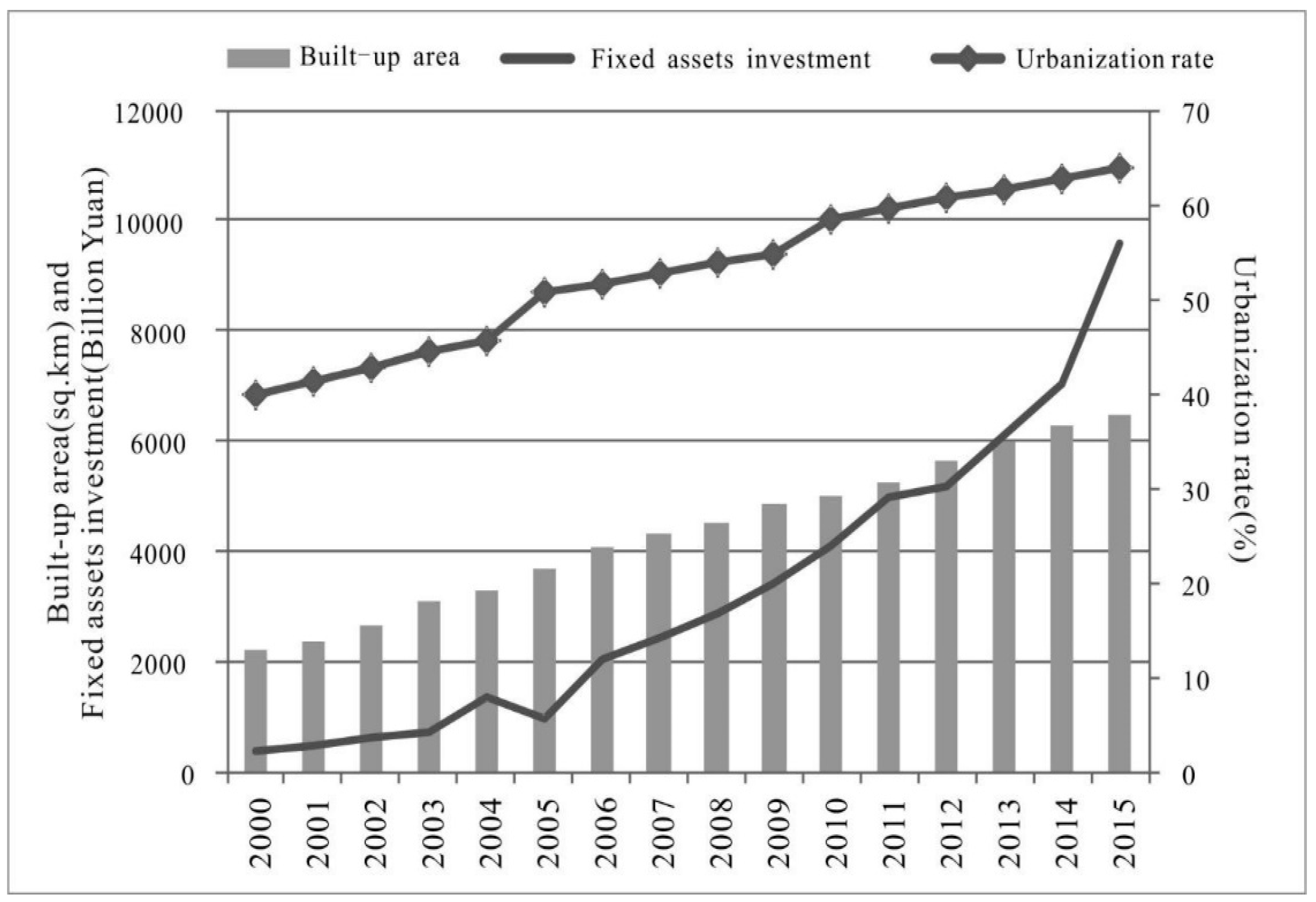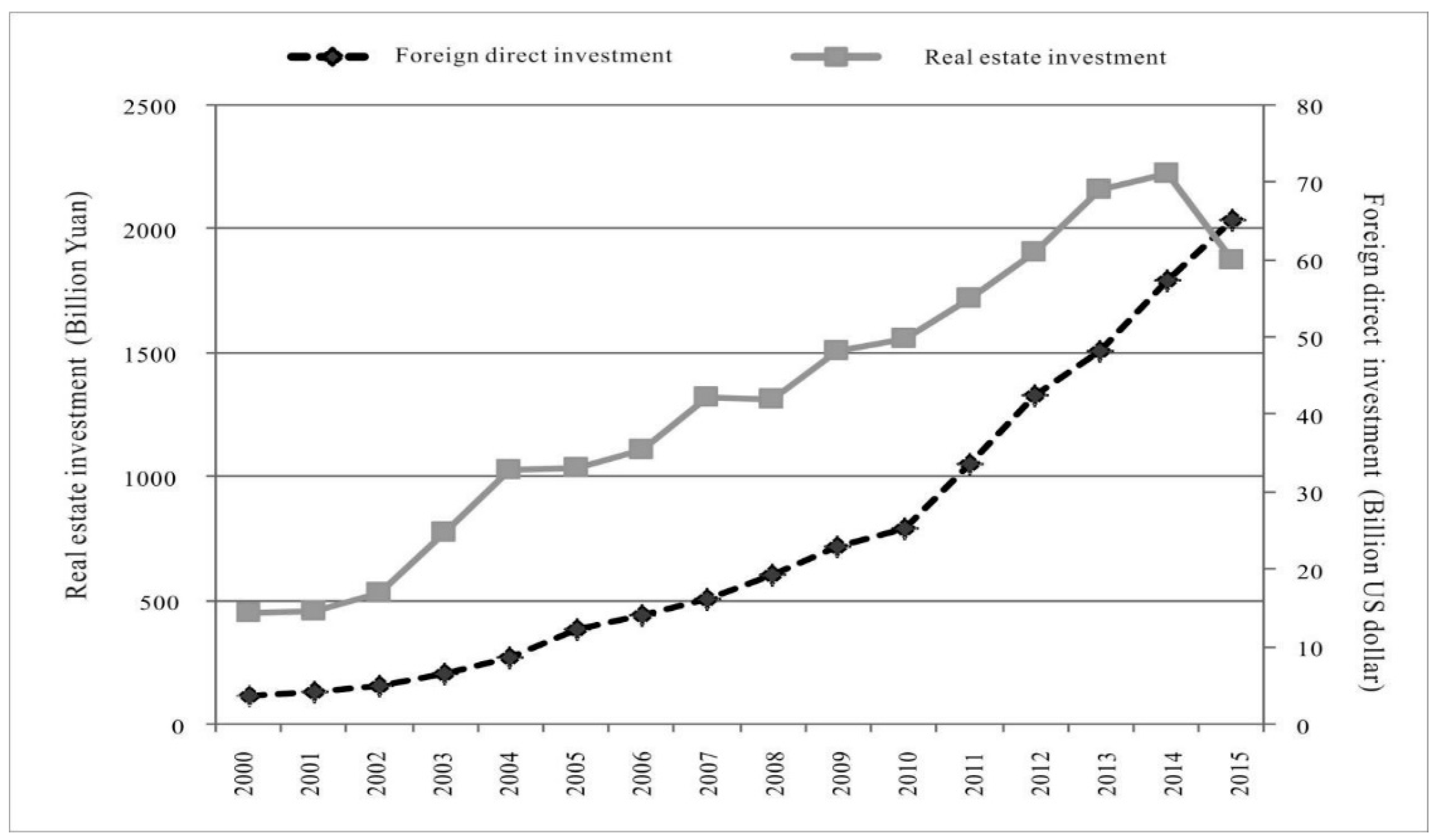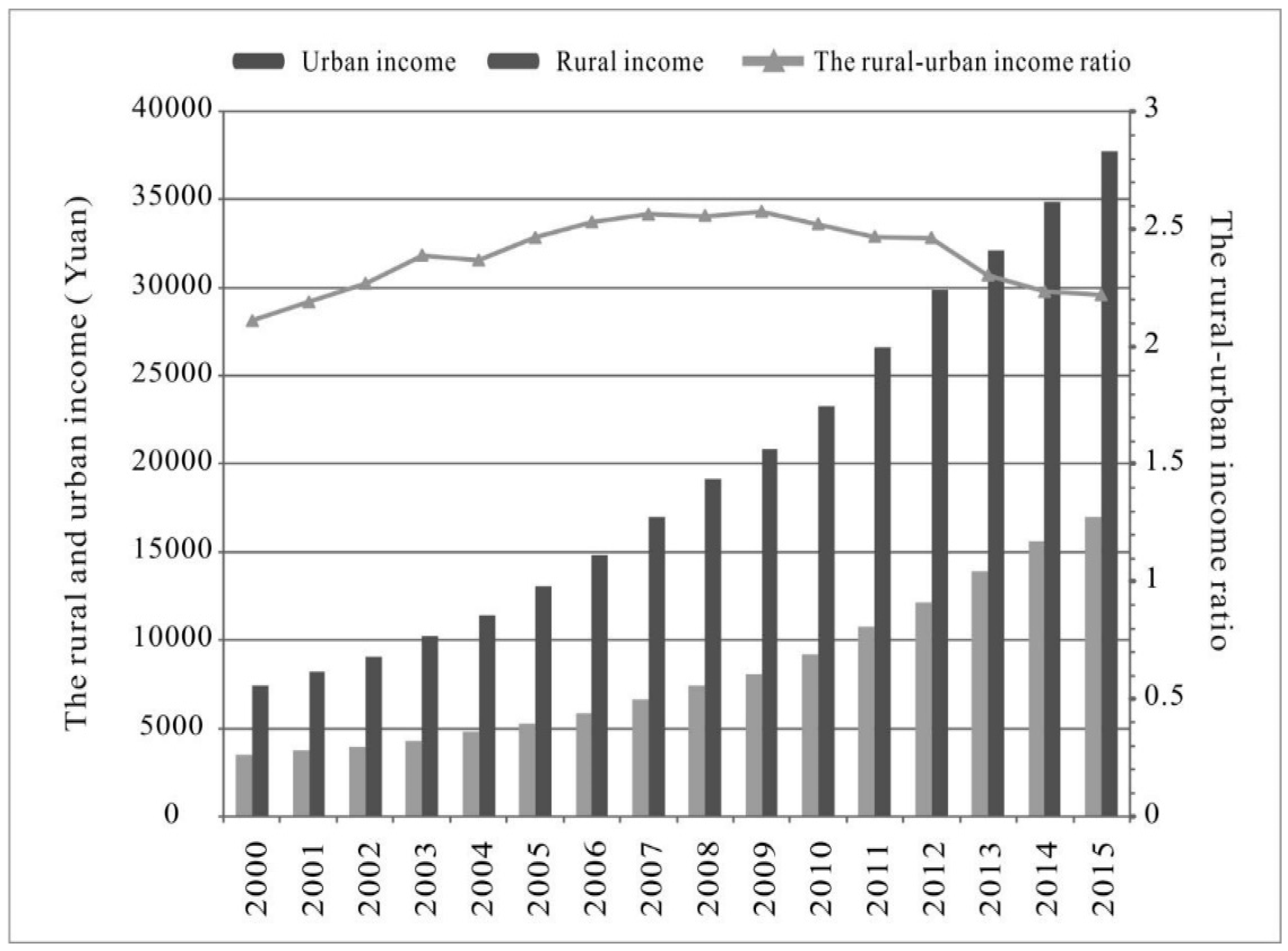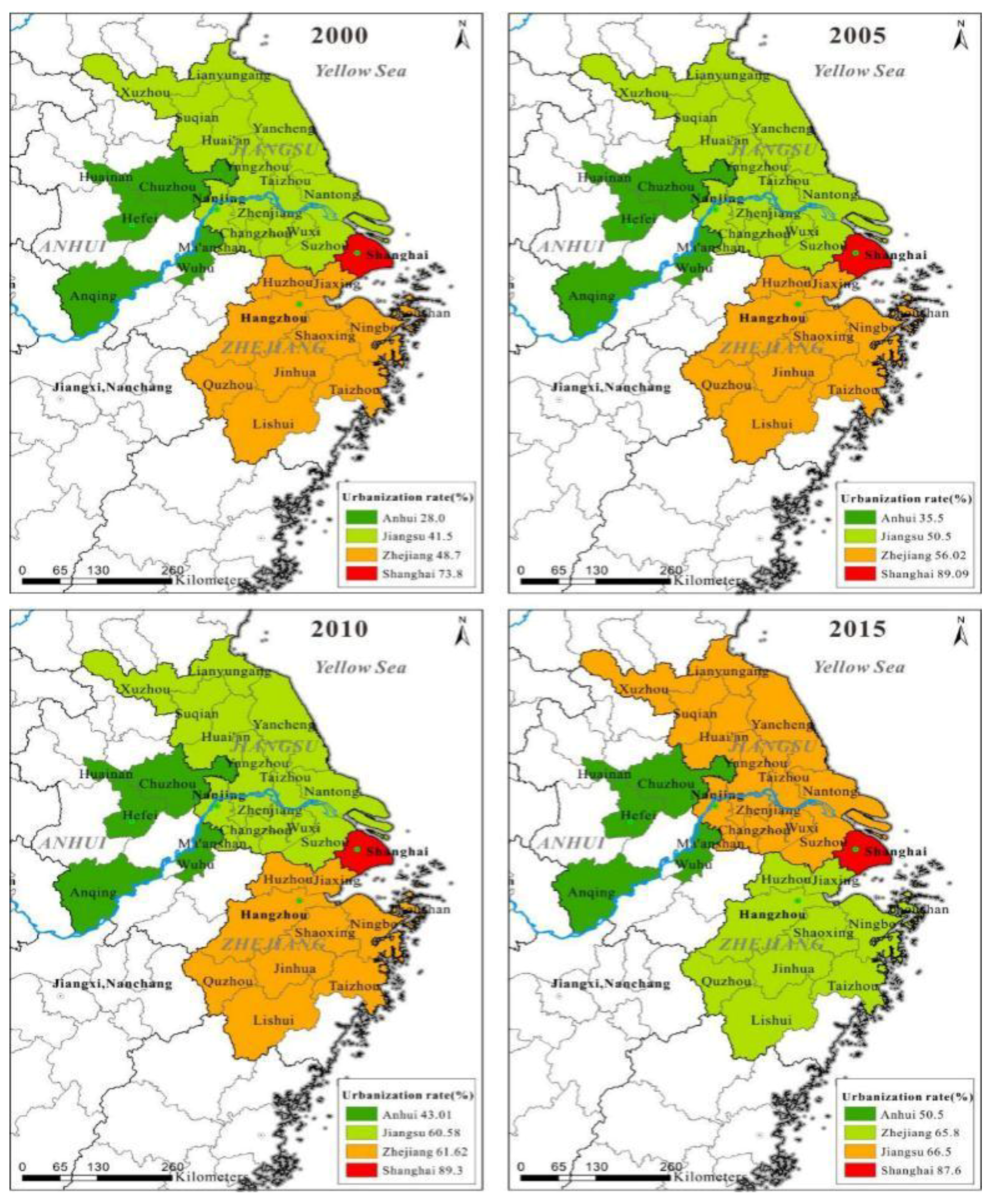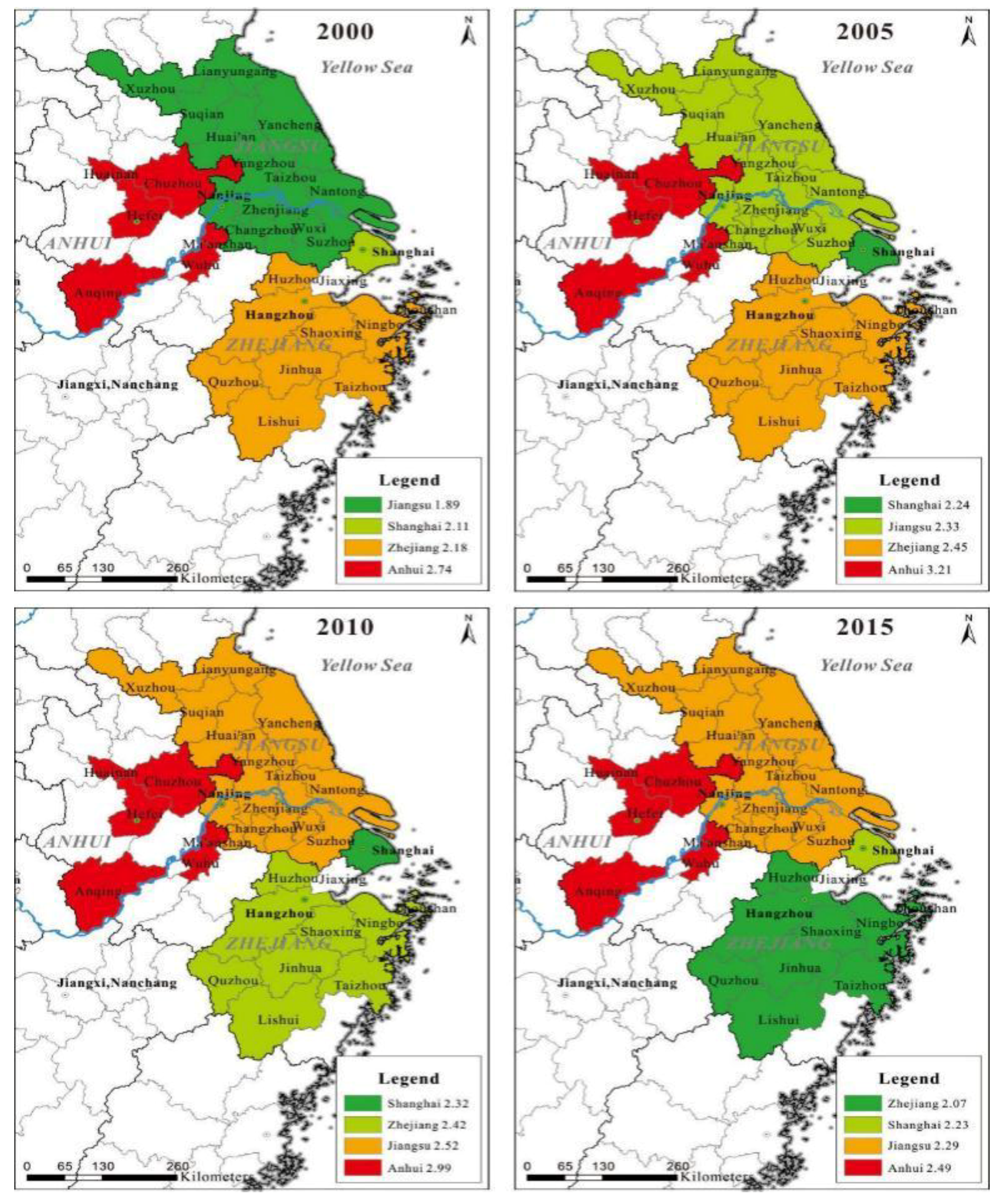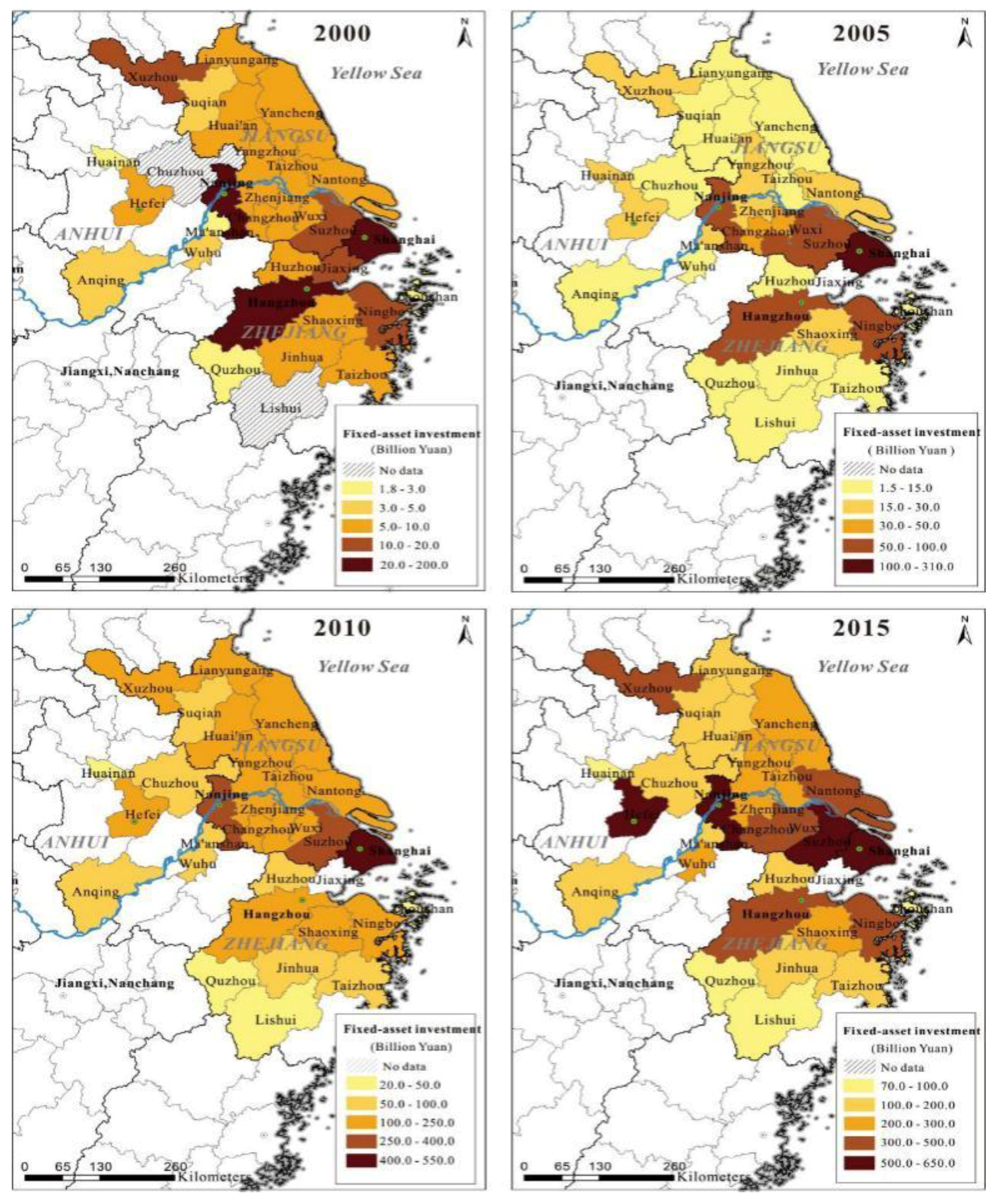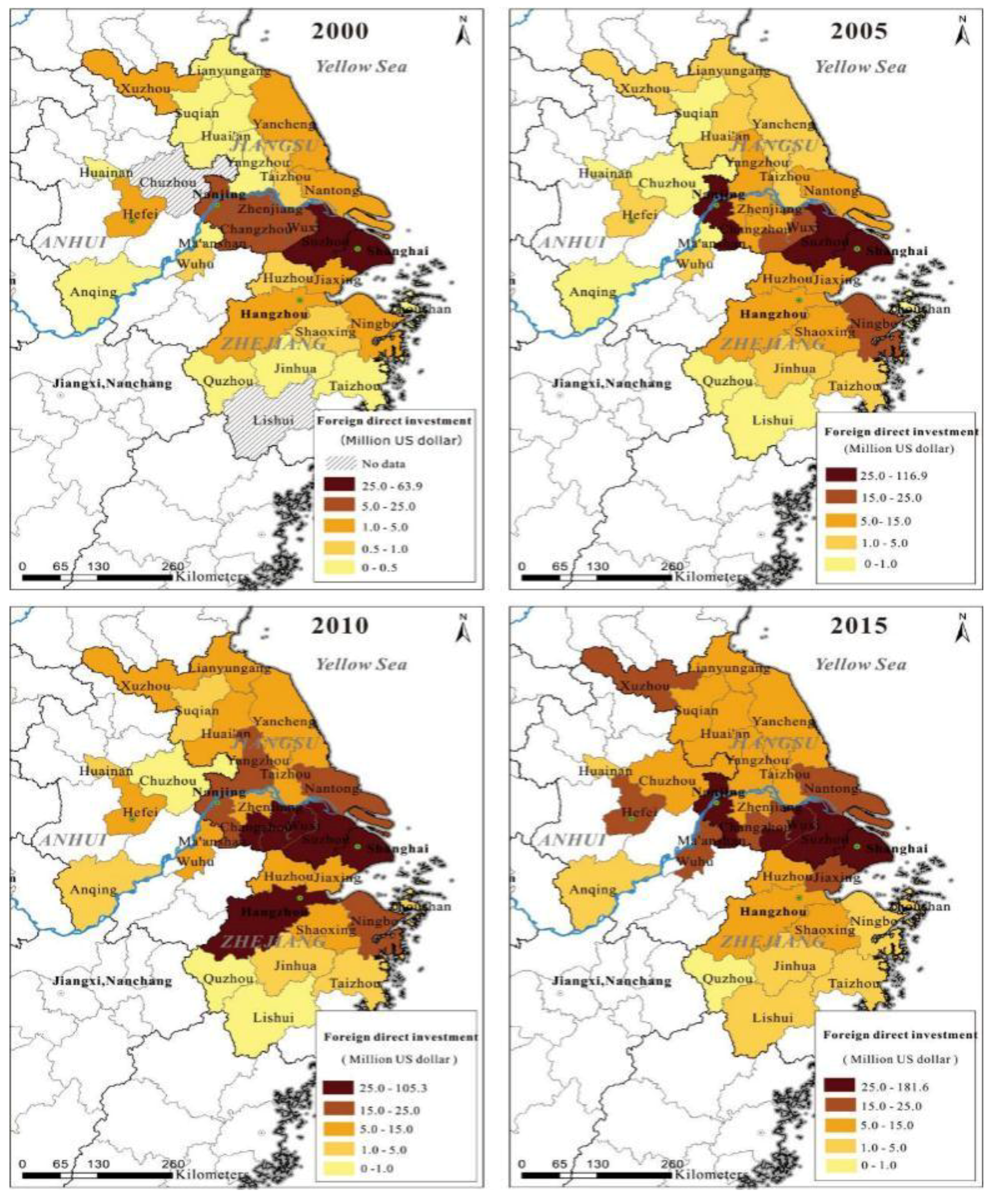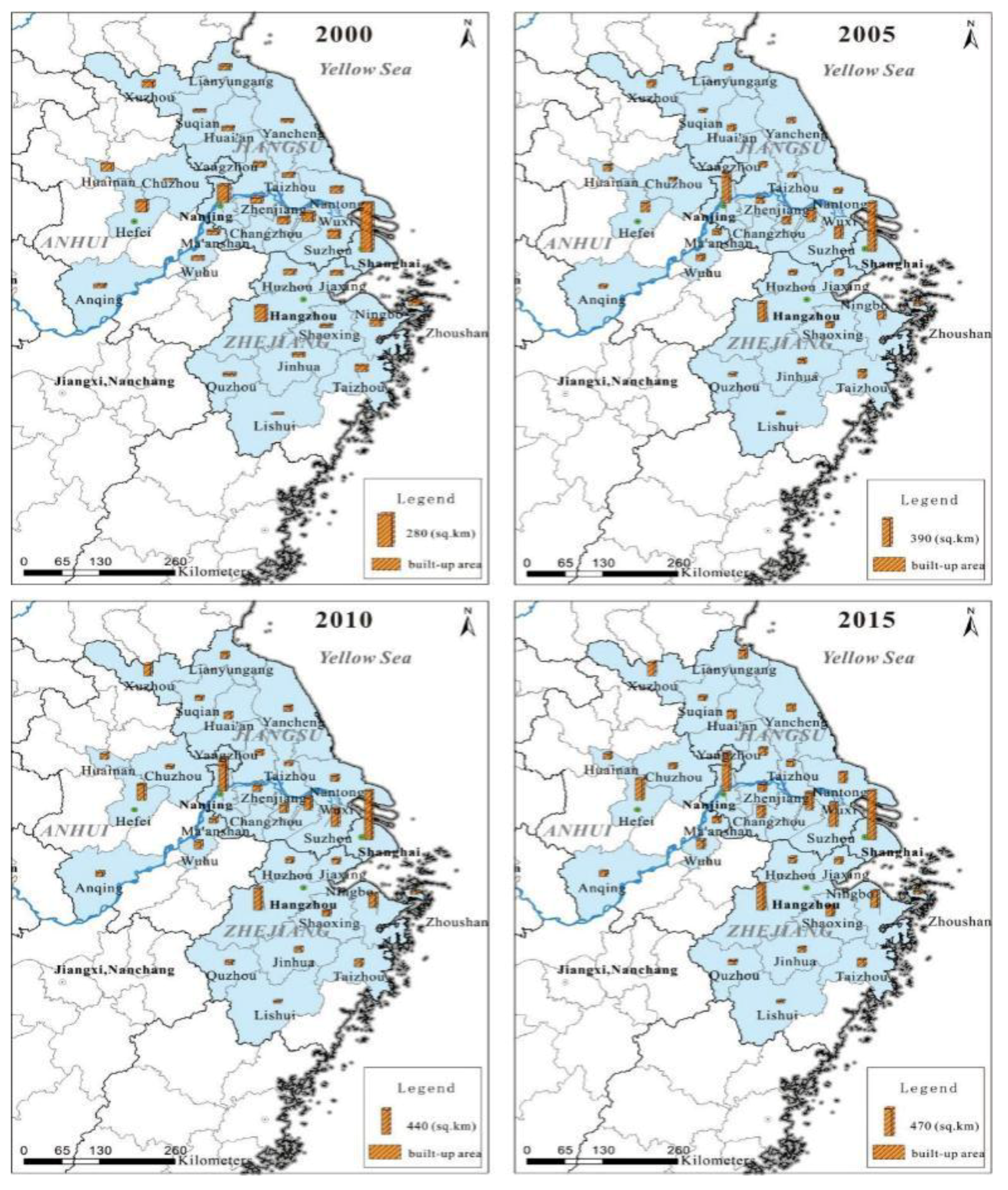3.1. Unbalanced Development of the YRDUA
The YRDUA is the biggest comprehensive industrial base in China and has a prominent location that lies within the intersection of the Gold Coast of Eastern China and the Golden Waterway of the Yangtze River. Since 1992, the YRD has taken the lead in the process of regional integration reform, and global capital has started to be poured into the YRD. Since 2000, the YRD has become one of the regions with one of the highest economic growth rates and the fastest speed of urbanization in China, even in the world, which maintains the highest degree of urbanization and has the most densely distributed towns. Compared with urban agglomerations in other countries, the speed and scale of urbanization in the YRD also rank high on the list [
39]. The population of the YRDUA exceeded 200 million in 2016, which was close to the world-class urban agglomerations of North America, Western Europe, and Japan. The spatial scale of the YRDUA has undergone a historical process of development which changes from a geographical concept to an economic concept and extends from small scale to large scale. According to the Development Planning of the YRDUA issued by National Development and Reform Commission, the YRDUA covers Shanghai, and Nanjing, Wuxi, Changzhou, Suzhou, Nantong, Yancheng, Yangzhou, Zhenjiang, and Taizhou of Jiangsu Province; Hangzhou, Ningbo, Jiaxing, Huzhou, Shaoxing, Jinhua, Zhoushan, and Taizhou of Zhejiang Province; and Hefei, Wuhu, Ma’anshan, Tongling, Anqing, Chuzhou, Chizhou, and Xuancheng of Anhui Province, see
Figure 2.
During the process of reform and opening up in the past 40 years, the economy of the YRD has been greatly developed. The GDP of the YRD reached 12.9 trillion yuan in 2014, accounting for 20.25% of the total country’s GDP and was far higher than the national average level and other domestic urban agglomerations. Shanghai is dominant and has become one of the most important cities in the world. However, with the continuous spread of globalization, the development of cities in the YRD not only shows the trend of regional integration and spatial pattern of a multi-core network but also forms some metropolitan areas with the core of megalopolis like Shanghai, Nanjing, and Hangzhou. In 2015, the GDP per capita of Shanghai was 125,002 yuan; Zhejiang was 77,644 yuan; Jiangsu was 87,995 yuan, and Anhui was 35,997 yuan. The GDP per capita of Shanghai was over three times the GDP per capita of Anhui province and was about 1.5-times those of the Zhejiang and Jiangsu Provinces. The uneven distribution of resources, environment, capital, and policies leads to the imbalance of urban economic development inside the YRDUA, which has become a problem that cannot be ignored.
Uneven development is the core issue in understanding the production of space. Uneven development is the systematic geographical expression of the contradictions of the capitalist system [
40]. Here, geographical conditions are both base and dynamic of regional or national development, which have been changed and reshaped in the production of space [
22].
3.2. The YRDUA Driven by Capital and Power
During the evolution process of the YRDUA, Chinese national departments have issued relevant documents to guide them in recent years. From this perspective, building the YRDUA into a world-class urban agglomeration is not only the development orientation of itself but also Chinese governments’ aim, which means power plays a crucial role in shaping and promoting the YRDUA.
During the years 2001 to 2016, sets of documents regarding the development of urban agglomeration were issued by different departments, see
Table 1 and
Table 2, and the idea of taking urban agglomeration as the main form of future urban development was put forward by almost all of the documents. According to the documents for the development of the YRDUA, the common orientation is to form it into an important economic growth pole and then a world-class urban agglomeration with international competitiveness by promoting and optimizing international cooperation and competition at a higher level.
There are some remarkable differences among these documents regarding the orientation of the YRDUA. From the main national policies, “the 11th 5-Year plan” in 2006 first put forward the concept of urban agglomeration and regarded it as the main form of urban development to give priority to regional and national economic issues. “The 13th 5-Year plan” was based on this concept but came up with a deeper idea of internationalization, to gradually build some world-class urban agglomerations with more international and comprehensive competitiveness. After “the 12th 5-Year plan” had achieved some aims, the pursuit of faster and greater development was put forward by “the 13th 5-Year plan” which included optimizing and enhancing the function of the YRDUA. Under the guidance of Communist Party of China Central Committee’s relevant documents, the departments including the State Council, the National Development and Reform Commission, and the Ministry of Housing and Urban-Rural Development all issued relevant documents which were more detailed and provided targeted supplementary and improvement in the view of the new situation and different urban agglomerations. Overall, although the contents of documents in each period are different, all departments expressed great expectations with regard to the development of the YRDUA, while it aimed at constructing a world-class urban agglomeration and playing a leading role in the national economic and social development through accelerating the formation of new advantages in international competition [
41].
Over 15 years, FAI and FDI of the YRDUA have a similar changing trend, and the urbanization ratio basically shows a trend of linear growth. The evolution of built-up area and REI have a strong correlation (see
Figure 3 and
Figure 4). According to the relevant indexes, the development of the YRDUA can be divided into three periods, in which the year 2005 (the 11th Five-Year plan) and 2010 (the 12th Five-Year plan) are the turning points. The period of the years 2000–2005 can be referred to as the embryonic stage. There is an overall increasing trend but the development trend of each index remains relatively steady. This period can be described as the rapid development stage, in which each statistical index increases rapidly. The period of 2010–2015 is the sharp expansion stage when each index overall increases at an exponential speed, which is different from the previous two stages. For example, FAI and FDI have shown a strong momentum of growth. Although the overall evolution of each statistical index shows such a trend, there are some differences during certain separate years. For example, the scale of FAI did not increase but declined in 2005. Similarly, REI of the YRDUA in 2005 was basically the same as that in 2004 with no increase, as shown in
Figure 3 and
Figure 4. The underlying causes of the index changes will now be analyzed and explained.
Domestic and foreign capital investment which includes FAI, REI, and FDI, basically show similar variations to the urbanization ratio. After China joined the WTO (World Trade Organization) in 2001, FDI played a more important role than ever in the YRD. The growth of a built-up area is closely related to domestic capital investment, and FDI which includes REI makes a great contribution to the growth of the urbanization ratio. FDI has experienced a roughly exponential growth from 2000 to 2015, with the same trend of built-up areas and the urbanization ratio. It illustrates that foreign capital has a strong influence on the development of the YRDUA.
The government has played a crucial role from “the 10th 5-Year plan” to “the 12th 5-Year plan”. The state power leads to a city building movement, and an increase for the index which reflects the influence of power. For example, the built-up area was astonishingly expanded to almost three times the original size, from 2211 km2 in 2000 to 6452 km2 in 2015. It exhibits considerable variation and is consistent with the rapid urbanization in the YRDUA.
The built-up areas of Shanghai, Nanjing, Hangzhou, and Hefei, as the four core cities of the YRDUA, increased from 550–935 km2, 194–734 km2, 171–495 km2, and 120–403 km2, respectively, from 2000 to 2015. The built-up area of Shanghai increased by 1.7-times and the built-up area of the other three cities all increased by about four times. Presently, there is a new spatial pattern with Nanjing, Hangzhou, and Hefei as the centers of the urban network. The conversion of idle land into industrial or commercial land is a common method to achieve rapid development and improve the level of urbanization.
The YRDUA is one of the regions that primarily promoted urbanization in China, and the income gap between the urban and the rural is far less than the national average level. The URIR in China reached over 3, and during the year 2000 to 2015, the URIR of the YRDUA was between 2.1 and 2.6, while internationally, the highest value was only about 2. Furthermore, a clear differentiation or alienation between the rural and the urban in the YRDUA existed mainly because of uneven geographical development in which resources and the welfare system were distributed in an unbalanced manner between rural and urban areas, as shown in
Figure 5. The coastal cities and counties often received more foreign and domestic investment while the rural areas were always overlooked. It is difficult for rural areas to absorb the investment and capital because it is marginalized by the policymakers and developers. As a result, with the rapid development of urbanization, the urban-rural gap enlarges stage by stage.
With rapid urbanization in the YRD, the index of URIR reached the maximum in 2009. The change of URIR can be divided into two parts, and the year 2009 is the turning point. In the first stage, the URIR continuously increased from 2.11 in 2000 to 2.57 in 2009. During this time period, the URIR decreased from 2.39 in 2003 to 2.37 in 2004 and it was relatively low because there were a large number of low-income people in urban and the rural areas. With the acceleration of urbanization, the income level of urban residents was higher than that of rural residents, which caused a wider income gap between urban and rural areas. In the second stage from 2009 to 2015, the URIR continuously decreased even though the index of URIR was over 2.5 from 2006 to 2010 and it had reached the maximum in 2009. The national related departments have intensively issued a series of policies and guiding opinions for the development of the YRDUA between 2006 and 2010, see
Table 1 Moreover, during this period, the evolution of the index including FAI, FDI, and REI showed an increasing trend, which means that power and capital push the rapid urbanization and also enlarge the income gap between urban and rural areas. The difference range of the URIR between the years 2015 and 2000 was only 0.1, which shows that it basically remained the same. It illustrates that the living standards of urban and rural residents have increased since 2009.
3.3. Growing Regional and Social Inequality: Urbanization, Capital, and Urban-Rural Disparities
The urbanization ration of all provinces in the YRDUA has increased significantly since 2000, see
Figure 6. Shanghai has been the top city while Anhui province has been at the lowest level according to their urbanization ratio. The gap between provinces has gradually narrowed. The difference range narrowed by approximately 1.2 times, from 0.458 in 2000 (Shanghai as the maximum 0.738, Anhui as the minimum 0.280) to 0.371 in 2015 (Shanghai as the maximum 0.876, Anhui as the minimum 0.505). The spatial pattern shows evident regional differences between Shanghai, Zhejiang, Jiangsu, and Anhui. Shanghai always has the highest urbanization ratio, followed by Zhejiang and Jiangsu, while Anhui has the lowest urbanization ratio. In 2015, the urbanization ratio of Jiangsu surpassed that of Zhejiang for the first time and became the province with the second highest urbanization ratio in the YRDUA. At the provincial scale, the urbanization ratios of Hangzhou, Ningbo, Nanjing, Suzhou, and Hefei were much higher than those of other cities in the province, and the urbanization of them has been increasing at a faster but still relatively low speed [
22].
The increasing URIR will further aggravate social and regional inequality. In China, the rural and urban areas are not only two kinds of space but also two main social classes, and the residents of these two classes have a deep gap in terms of infrastructure, welfare, medical services, and income, etc. The index of URIR is mainly used to illustrate the influence of class in the process of urbanization in the YRDUA. For the YRD as a whole, the average URIR is becoming smaller which means that the income gap between urban and the rural areas has widened. However, there has been an evident difference between all provinces in the YRD, see
Figure 7. Because of the high urban-rural coordination based on economic development, the difference of URIR between Shanghai, Zhejiang, and Jiangsu were smaller compared to that of capital and power, and the index of URIR was relatively low. However, the URIR of Anhui has been at a relatively high level constantly, as the highest among the provinces, though it narrowed from 2.74 in 2000 to 2.49 in 2015. Due to the level of natural conditions, economic and social development, and other factors, China’s urbanization showed obvious regional differences. The gap was gradually widening, and indicated the uneven development inside each urban agglomeration and provincial regions.
The index of FAI is used to show the influence of capital on the urbanization process of the YRDUA. From 2000 to 2015, the amount of FAI in almost every city has been growing gradually, see
Figure 8. However, there were evident differences between different parts of the YRD. Cities around the Yangtze River basin have the highest FAI followed by Jiangsu, Zhejiang, and Anhui province. During this stage, Shanghai was the leading city in the amount of FAI while Tongling in Zhejiang province was essentially at the bottom. Moreover, the gap of FAI between cities rose by almost 20 times, from 394,678 billion Yuan in 2000 (Shanghai as the maximum 185,671, Zhoushan as the minimum 1807) to 8081.367 billion Yuan in 2015 (Shanghai as the maximum 60.297, Tongling as the minimum 66.508). The FAI of 13 cities in Jiangsu province was relatively high, which ranged from 106.927 billion Yuan in 2000 to 4155.275 billion Yuan in 2015, while the FAI of six cities in Anhui province ranged from 20,569 billion Yuan to 1276.82 billion Yuan. This fact indicates that cities in different provinces or in the same province have huge differences in their capital investment which lead to their urbanization ratio difference, see
Figure 6.
The FDI can directly indicate the influences of foreign capital in the process of urbanization in the YRDUA. According to the spatial evolvement of the FDI in the YRDUA from 2000 to 2015, see
Figure 9, there is a large and obvious gap in FDI between cities around the Yangtze River basin and other cities in the Anhui, Zhejiang, and Jiangsu provinces; however, the FDI of all cities in the entire YRD region constantly increased in this stage. Shanghai and Suzhou have played a leading role since 2000. Taking cities around the Yangtze River Basin as the center, the cities of Zhejiang and Jiangsu province, close to Shanghai, have gradually expanded the scale of FDI since 2005, mainly because of a superior geographical location and convenient traffic. In 2000, the FDI of Shanghai was 6390 billion dollars, soaring to 18.166 billion dollars in 2015. In 2000, the city with the lowest FDI of only 8.69 million dollars was Zhoushan in Zhejiang province, and its FDI reached 200 million dollars in 2015. The difference in FDI between Shanghai and Zhoushan narrowed from 735 times to 90 times. In 2015, Nanjing and Wuxi also ranked among those with the largest amount of FDI after Shanghai and Suzhou.
The spatial distribution and evolvement of FDI have generally aligned with the changing trends of urbanization and have basically remained unchanged since 2000. Since China joined WTO in 2001, developed countries such as the USA have also increased their investment in the YRD. More and more industries and factories have been investing, and the foreign investment has been infiltrating with increasing speed into the service industry such as commerce, securities, insurance banks, and other industries. The uneven distribution and growth of FDI in the inner urban agglomeration is one of the main causes of the increasing gap in regional economic development. From the distribution map of FDI in 2015, when capital cannot accumulate and grow in one region, it will find another region to absorb and digest surplus capital using a variety of mechanisms. This will further expand the uneven development in the urban agglomeration.
The index of built-up areas demonstrates the influence of power in the YRDUA. The built-up area has been rapidly expanding at a large scale in almost every city of the urban agglomeration every year. The regional and spatial differences are mainly shown in two aspects, see
Figure 10. Firstly, the built-up area of four cities including Shanghai, Hefei, Nanjing, and Hangzhou has expanded sharply. Secondly, the differences between cities in different provinces or in the same province increased during the years 2000 to 2015. The difference range increased from 3690 km
2 in 2000 (Shanghai as the maximum 550 km
2, which is almost 32 times that of the minimum, Tongling at 17 km
2) to 6452 km
2 in 2015 (Shanghai with the maximum 935 km
2, which is over 27.5 times that of Tongling with the minimum of 34 km
2).
In some cities, such as Shanghai, Hefei, Nanjing, and Hangzhou, the changing trends in their built-up areas are similar to that of the YRD overall. Shanghai has the built-up area which has expanded the most; the built-up area increased by 385 km2, from 550 km2 in 2000 to 935 km2 in 2015. The built-up areas of Hefei, Nanjing, and Hangzhou have increased by 283 km2, 540 km2, and 324 km2, respectively. The development of the YRDUA and the acceleration of urbanization are in the form of scale expansion. At first, it is influenced by capital investment including domestic investment and foreign investment. The curve of foreign investment has been continuously rising, although the growth rate of REI has been less than that of FDI and has fluctuated in some years. Moreover, it is affected by spatial expansion, which is reflected in the increasing built-up area. As the central cities of the YRD, Shanghai, Hefei, Nanjing, and Hangzhou are more powerful than other cities, which helps ensure the priority of expanding their built-up areas.
